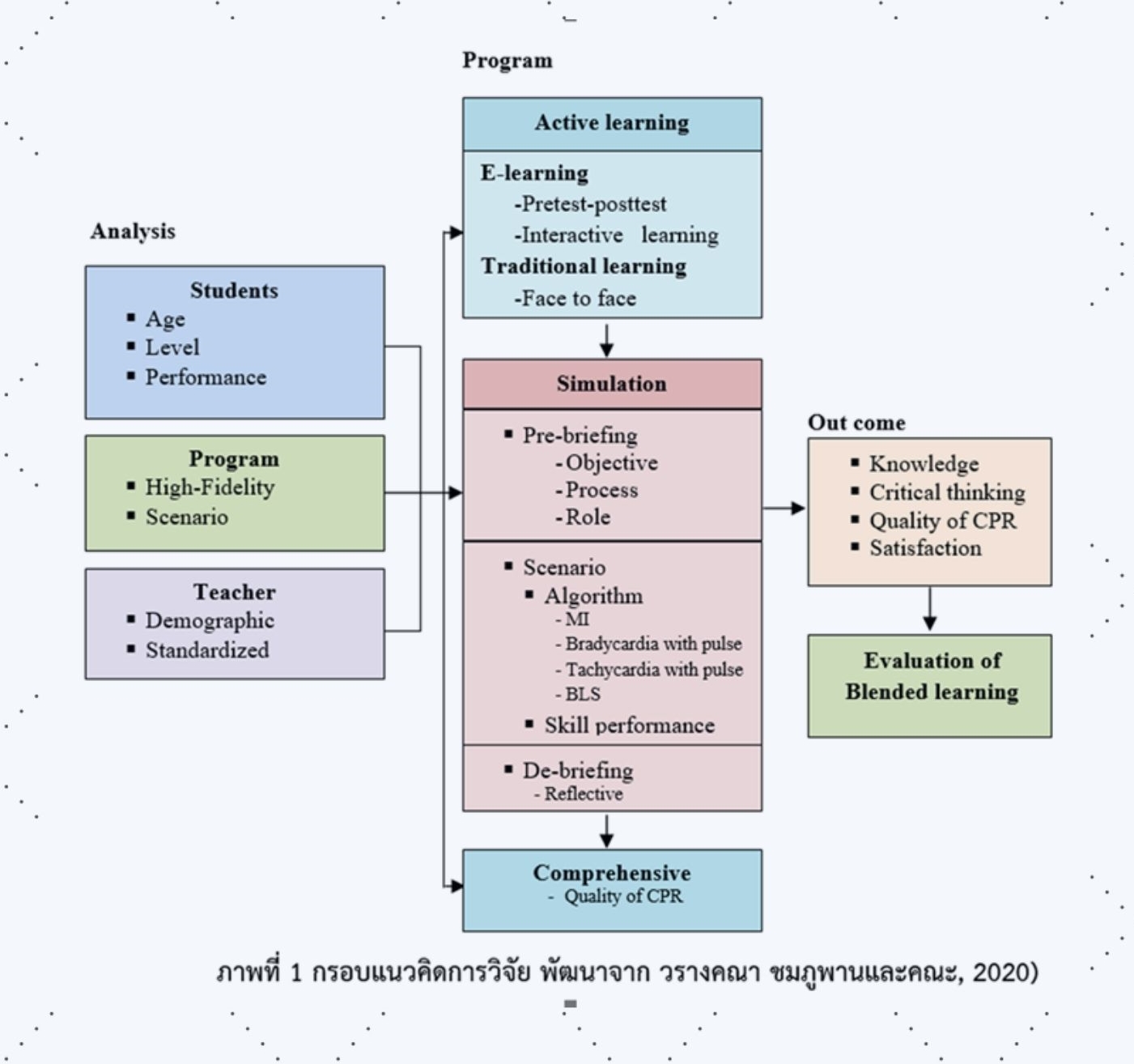การประเมินผลโปรแกรมการเรียนรู้ด้วยรูปแบบการเรียนผสมผสาน ในการดูแลผู้ป่วยฉุกเฉิน
คำสำคัญ:
การเรียนผสมผสาน, การคิดอย่างมีวิจารณญาณ, คุณภาพการช่วยฟื้นคืนชีพขั้นพื้นฐานบทคัดย่อ
วัตถุประสงค์งานวิจัยครั้งนี้ เพื่อประเมินผลโปรแกรมการเรียนรู้ด้วยรูปแบบการเรียนผสมผสานในการดูแลผู้ป่วยฉุกเฉิน เปรียบเทียบความรู้ การคิดอย่างมีวิจารณญาณ คุณภาพการช่วยฟื้นคืนชีพขั้นพื้นฐานและความพึงพอใจรูปแบบการสอนก่อน-หลังการทดลอง กลุ่มตัวอย่าง นักศึกษาหลักสูตรประกาศนียบัตรวิชาชีพชั้นสูง สาขาปฏิบัติการฉุกเฉินการแพทย์ วิทยาลัยการสาธารณสุขสิรินธร จังหวัดขอนแก่น ชั้นปีที่ 2 จำนวน 33 คน
ผลการศึกษา พบว่า โปรแกรมการเรียนรู้ด้วยรูปแบบการเรียนผสมผสานในการดูแลผู้ป่วยฉุกเฉินมีองค์ประกอบของการประเมินครบตามแผนการจัดการเรียน การประเมินแผนการเรียนการสอนภาพรวมอยู่ในระดับดีมาก ผู้เรียนมีคะแนนความรู้หลังการทดลองเพิ่มขึ้น 4.15 คะแนน คะแนนการคิดอย่างมีวิจารณญาณเพิ่มขึ้น 27.38 คะแนน คะแนนคุณภาพการช่วยฟื้นคืนชีพขั้นพื้นฐาน เพิ่มขึ้นจากเกณฑ์มาตรฐาน 15.47 คะแนน และมีคะแนนความพึงพอใจต่อรูปแบบการสอน เพิ่มขึ้น 5.85 คะแนน อย่างมีนัยสำคัญทางสถิติ
ดังนั้นการเรียนรู้ด้วยรูปแบบผสมผสานสามารถเพิ่มความรู้ ทักษะในการดูแลผู้ป่วยฉุกเฉิน และสามารถส่งเสริมให้ผู้เรียนมีสมรรถนะการดูแลผู้ป่วยฉุกเฉินได้มากขึ้น
เอกสารอ้างอิง
Adib-Hajbaghery, M., & Sharifi, N. (2017). Effect of simulation training on the development of nurses and nursing students' critical thinking: A systematic literature review. Nurse Educ Today, 50, 17-24. doi: 10.1016/j.nedt.2016.12.011
Berga, K.-A., Vadnais, E., Nelson, J., Johnston, S., Buro, K., Hu, R., & Olaiya, B. (2021). Blended learning versus face-to-face learning in an undergraduate nursing health assessment course: A quasi-experimental study. Nurse education today, 96, 104622.
Berger, B. A., & Villaume, W. A. (2016). A new conceptualization and approach to learning and teaching motivational interviewing. INNOVATIONS in pharmacy, 7(1).
Berger, C., Brinkrolf, P., Ertmer, C., Becker, J., Friederichs, H., Wenk, M., . . . Hahnenkamp, K. (2019). Combination of problem-based learning with high-fidelity simulation in CPR training improves short and long-term CPR skills: a randomised single blinded trial. BMC medical education, 19(1), 1-10.
Chompoopan, W., Chompoopan, W., Chanaboon, A., Seedaket, S., & Yomseeken, J. (2020). Effects of a Simulation-Based Learning Model for Medical Management of Patients with Cardiovascular Diseases. Nursing Journal of The Ministry of Public Health, 30(2), 93-103. (in Thai)
de Brito Lima, F., Lautert, S. L., & Gomes, A. S. (2021). Contrasting levels of student engagement in blended and non-blended learning scenarios. Computers & Education, 104241.
De Gagne, J. C., Kim, S. S., Schoen, E. R., & Park, H. K. (2018). Assessing the Impact of Video-Based Assignments on Health Professions Students’ Social Presence on Web: Case Study. JMIR medical education, 4(2), e11390.
Demirtas, A., Guvenc, G., Aslan, Ö., Unver, V., Basak, T., & Kaya, C. (2021). Effectiveness of simulation-based cardiopulmonary resuscitation training programs on fourth-year nursing students. Australasian Emergency Care, 24(1), 4-10.
Ennis, R. H. (1985). A logical basis for measuring critical thinking skills. Educational leadership, 43(2), 44-48.
Gerdprasert, S., Pruksacheva, T., Panijpan, B., & Ruenwongsa, P. (2010). Development of a web-based learning medium on mechanism of labour for nursing students. Nurse Educ Today, 30(5), 464-469. doi: 10.1016/j.nedt.2009.10.007
Grossman, P., Hammerness, K., & McDonald, M. (2009). Redefining teaching, re‐imagining teacher education. Teachers and Teaching: theory and practice, 15(2), 273-289.
Hellermann, C., Gold, B., & Holodynski, M. (2015). Förderung von Klassenführungsfähigkeiten im Lehramtsstudium. Zeitschrift für Entwicklungspsychologie und pädagogische Psychologie.
Jensen, K. T., Knutstad, U., & Fawcett, T. N. (2018). The challenge of the biosciences in nurse education: A literature review. Journal of clinical nursing, 27(9-10), 1793-1802.
Kang, J., & Seomun, G. (2018). Evaluating web-based nursing education’s effects: a systematic review and meta-analysis. Western Journal of Nursing Research, 40(11), 1677-1697.
Korpershoek, H., Harms, T., de Boer, H., van Kuijk, M., & Doolaard, S. (2016). A meta-analysis of the effects of classroom management strategies and classroom management programs on students’ academic, behavioral, emotional, and motivational outcomes. Review of Educational Research, 86(3), 643-680.
Larson, D. K., & Sung, C.-H. (2009). Comparing student performance: Online versus blended versus face-to-face. Journal of Asynchronous Learning Networks, 13(1), 31-42.
Li, C., He, J., Yuan, C., Chen, B., & Sun, Z. (2019). The effects of blended learning on knowledge, skills, and satisfaction in nursing students: A meta-analysis. Nurse education today, 82, 51-57.
Murray, B., Judge, D., Morris, T., & Opsahl, A. (2019). Interprofessional education: A disaster response simulation activity for military medics, nursing, & paramedic science students. Nurse education in practice, 39, 67-72.
Narciss, S. (2013). Designing and evaluating tutoring feedback strategies for digital learning. Digital Education Review(23), 7-26.
Owston, R., York, D. N., & Malhotra, T. (2019). Blended learning in large enrolment courses: Student perceptions across four different instructional models. Australasian Journal of Educational Technology, 35(5), 29-45.
Pannee leekitwattana (2016). Research methods in education. Bankok: min service and supply 2559. (in Thai)
Panumaporn, J., Soisudarat, C., & Meechanphet, V. (2014). Development of Learning Program to Enhance Critical Thinking Skills Based on Bloom’s Theory in Advertising Media Consumption. Bangkok: Faculty of Psychology, Chulalongkorn University. (in Thai)
Porter, W. W., Graham, C. R., Bodily, R. G., & Sandberg, D. S. (2016). A qualitative analysis of institutional drivers and barriers to blended learning adoption in higher education. The internet and Higher education, 28, 17-27.
Prilop, C. N., Weber, K. E., & Kleinknecht, M. (2020). Effects of digital video-based feedback environments on pre-service teachers’ feedback competence. Computers in Human Behavior, 102, 120-131.
Rogers, C. R. (1995). On becoming a person: A therapist's view of psychotherapy: Houghton Mifflin Harcourt.
Rungswang, P., Ngudgartoke, S., Prommapun, B., & Subsombat, W. (2013). Development of an Evaluation Model for Authentic Assessment of Upper Secondary Students. Journal of education Khon Kaen University, 36(2): 64-73. (in Thai)
Shang, F., & Liu, C.-Y. (2018). Blended learning in medical physiology improves nursing students’ study efficiency. Advances in physiology education, 42(4), 711-717.
Smith, K., & Hill, J. (2019). Defining the nature of blended learning through its depiction in current research. Higher Education Research & Development, 38(2), 383-397.
Wangsrikoon, A. (2014). Education in Thailand towards 21st Century: Productivity and Trends of Educational Development. Humanities and Social Sciences Journal of Graduate School, Pibulsongkram Rajabhat University, 8(1), 1-17. (in Thai)
Yimyam, S., Charuwatcharapaniskul, U., Chareonsanti, J., Indarangkura Na Ayutthaya, A., Xuto, P., & Chaloumsuk, N. (2015). Developing on Blended Learning for Developing the 21st Century Learning Skills. Nursing Journal, 42, 129-140. (in Thai)
Zhang, J.-H., Zou, L.-c., Miao, J.-j., Zhang, Y.-X., Hwang, G.-J., & Zhu, Y. (2020). An individualized intervention approach to improving university students’ learning performance and interactive behaviors in a blended learning environment. Interactive Learning Environments, 28(2), 231-245.

ดาวน์โหลด
เผยแพร่แล้ว
รูปแบบการอ้างอิง
ฉบับ
ประเภทบทความ
สัญญาอนุญาต
ลิขสิทธิ์ (c) 2022 วารสารสาธารณสุขและวิทยาศาสตร์สุขภาพ

อนุญาตภายใต้เงื่อนไข Creative Commons Attribution-NonCommercial-NoDerivatives 4.0 International License.
บทความทุกบทความที่ได้รับการตีพิมพ์ถือเป็นลิขสิทธิ์ของ วารสารสาธารณสุข















